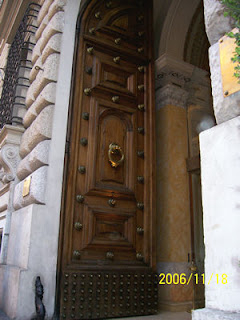

Still with our morning walks around Rome, we started noticing that most of the older buildings have fascinating doors, beautifully crafted in wood, iron or bronze. This one we found near our hotel in Via Nazionale. We thought maybe the doors had to be so tall and wide so that a Roman could drive straight through with his horse and chariot. It seems as if these doorways used to lead to inner courtyards, many of which have been built up in later years.

The Spanish Steps (Italian: Scalinata di Piazza di Spagna) is a set of stairs in Rome, ramping a steep slope between the Piazza di Spagna at the base and Piazza Trinita dei Monti, with the church under the patronage of the Bourbon kings of France, Trinita dei Monti, above. Unfortunately, at the time we were there they were busy restoring the column directly in front of the church, hence the ugly scaffolding.
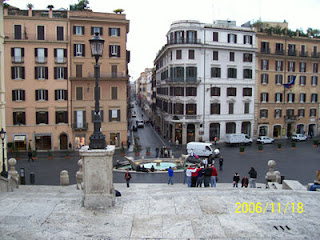
Here we were looking down the steps towards the Piazza di Spagna and the boat-shaped fountain. The monumental stairway of 138 steps was built with French diplomat Stefano Gueffier's funds (20,000 scudi) in 1723–1725, linking the Bourbon Spanish Embassy to the Holy See.

Up the steps and past the church, we soon came to the Villa Medici on top of the Pincian Hill. The gardens of the villa are contiguous with the larger Borghese gardens in Rome. The Villa Medici has housed the French Academy in Rome since 1803. In 1576 the property was acquired by Cardinal Ferdinando de' Medici, Grand Duke of Tuscany, who finished the structure to designs by Bartolomeo Ammanati. The Villa Medici was the first among the Medici properties in Rome, intended to give concrete expression to the ascendancy of the Medici among Italian princes and assert their permanent presence in Rome.

Looking down from the villa over the city clearly showed up the domes of various churches.
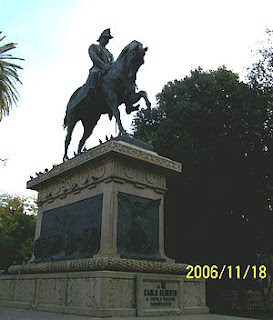
Another walk took us through the Gardino del Quirinale (the Quirinale Gardens), past the impressive statue of Carlo Alberto and from there on to the Quirinal Palace (known in Italian as the Palazzo del Quirinale or simply the Quirinale). Carlo Alberto was the King of Sardinia from 1831 to 1849. Although an Italian patriot opposed to Austrian hegemony in Northern Italy, he put down the Mazzini conspiracy. He introduced a series of reforms that abolished domestic customs barriers within the kingdom, promulgated a constitutional law code (Statuto Albertino) along Napoleonic lines and supported the arts and sciences. During the Revolutions of 1848 he agreed to a constitutional regime that remained in place for the century that the Kingdom of Italy lasted. He was succeeded by his son, Vittorio Emanuele II.
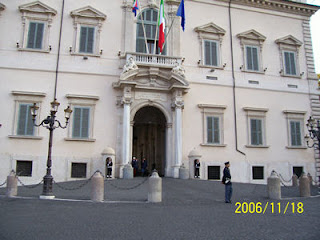
The Quirinal Palace (known in Italian as the Palazzo del Quirinale or simply the Quirinale) is now the official residence of the President of the Italian Republic upon the Quirinal Hill, one of the seven hills of Rome. The palace, located on the Via del Quirinale and facing onto the Piazza del Quirinale, was built in 1573 by Pope Gregory XIII as a papal summer residence. It was also used as the location for many papal conclaves. It served as a papal residence and housed the central offices responsible for the civil government of the Papal States until 1870. In September 1870 what was left of the Papal States was overthrown. About five months later, in 1871, Rome became the capital of the new Kingdom of Italy.

After first missing this imposing building (because we did not look around the corner) we were happy to stumble across the Barberini Palace. The suburban site was purchased in 1625 by Maffeo Barberini, who had come to the papal throne as Urban VIII. He employed three architects to plan the vast Renaissance block along the lines of Palazzo Farnese. However, the design quickly evolved into a precedent-setting combination of just such an urban seat of princely power combined with a garden front that had the nature of a suburban villa with semi-enclosed garden.

Today the Palazzo Barberini houses the Galleria Nazionale d'Arte Antica, one of the most important painting collections in Italy. We were happy to spend some time viewing some of the artworks.
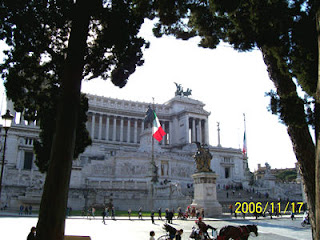
Equally fascinating and imposing is the monument to Victor Emmanuel. The Monumento Nazionale a Vittorio Emanuele II (National Monument of Victor Emmanuel II) or Altare della Patria (Altar of the Nation) is a monument designed and built by Giuseppe Sacconi between 1895 and 1911 to honour Victor Emmanuel, the first king of the unified Italy. He was the son of Carlo Alberto whom we have met before.
The monument is built of pure white marble and features majestic stairways, tall Corinthian columns, fountains, a huge equestrian statue of Victor Emmanuel and two statues of goddess Victoria riding on quadrigas. The monument holds the Tomb of the Unknown Soldier with an eternal flame, built under the statue of Italy after World War I. The base of the structure also houses the museum of Italian Reunification.
Find out about hotels in Rome.

No comments:
Post a Comment